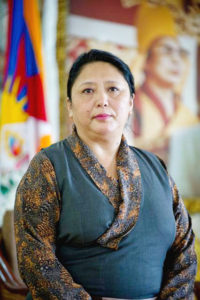 PROFILE:
PROFILE:
– Born in Kalimpong in 1964
Education:
– Attended the Central School for Tibetans (Darjeeling)
– Earned her BA in Political Science at Chandigarh University
– Earned her LLB at Delhi University
Work History:
– Executive Member of Regional Tibetan Youth Congress (RTYC) of Chandigarh (1982-1984)
– Information Secretary of Tibetan Youth Congress (TYC) (1986-)
– Joint Secretary of TYC (1989-1991)
– Member of Parliament (1991-2001) and Deputy Speaker (2001-2011) of the Central Tibetan Administration (CTA)
– Home Minister (Nangsi Kalon) of CTA (2011-2016)
Key Points:
– Ensure the long-term stability and welfare of CTA
– Vision for a gender and age-balanced cabinet
– Facilitate the settlement of exiled Tibetans worldwide
– Enhance Tibetan language education for exiled Tibetans
– Seek the Middle-Way Approach but anticipate restrategising if China continues current treatment
Former House Minister Gyari Dolma marks a prompt start to her 2021 Sikyong election campaign, publicising her campaign points in contention for the uppermost seat in the Tibetan administration in her virtual campaign launch held on August 14. Referring to her extensive experience in working for the Tibetan cause, she states, “I strongly believe that I can do justice to the office if elected.” As early as January, Dolma indicated her decision to run for the Sikyong position at a youth event organised by students at Delhi University’s Kirorimal College. At the youth event, she voiced her desire to “get the chance to serve [the] people and especially His Holiness the Dalai Lama closely once again”; she was been involved in the facilitation of the political devolution of His Holiness the Dalai Lama during her time as Minister.
As the first woman in history to contend for the Sikyong position, Dolma acknowledges the “huge responsibility” that accompanies her campaign. “I have to work harder, but it makes me perform better,” she explains in her campaign launch. In particular, she recognises the role of her election in communicating to China that “Tibetan women have taken up the mantle of leadership in exile”, and promises a gender and age-representative cabinet under her leadership.
Dolma describes the stability of the Central Tibetan Administration (CTA) as the essence of her political vision. The stability of the CTA, she says, depends on “democracy on the bedrock of rule of law […] and collective effort for the cause of Tibet.” With this in mind, she tells the reporters at her campaign launch that one of her primary manifestos is the formalisation of zero-interest loans for the administration’s civil servants, indicating its necessity in the long term welfare of the administration.
Another crucial manifesto that Gyari Dolma discloses is her proposition to reorganise Tibetan Community Associations around the world into Tibetan Settlement Offices. She explains that with the increasing number of exiled Tibetans in countries outside India, Tibetan Settlement Offices must likewise be available to protect the comfort and wellbeing of those who are living in exile. Furthermore, in order to ensure the preservation of the Tibetan language through education, she proposes the implementation of the 70,000 Character Petition* as a universal textbook for exiled Tibetans students.
While expressing her devoted support for the Middle-Way Approach (MWA)** at this campaign launch, Dolma anticipates an inevitable rethinking of the approach if Beijing continues to dismiss the administration’s efforts at resuming Sino-Tibetan dialogue. Some outlets, however, question the extent of her current adherence to the MWA, referring to her comments in a recent interview with CNN-News18. When asked about her thoughts on the Sino-Indian border dispute, Dolma stated that India must first “recognise Tibet as an independent nation” and “acknowledge the fact that the border today is not their Chinese border but the Tibetan one”. Regardless of whether this signifies her deviance from the MWA or not, many anticipate India’s greater involvement in Sino-Tibetan affairs under her leadership as Sikyong.
*The 70,000 Character Petition is a document written by the Tenth Panchen Lama and presented to the Zhou Enlai government in 1962. The petition reports and condemns the policies and conducts of the People’s Republic of China (PRC) in Tibet.
**MWA refers to the policy proposed by His Holiness the Dalai Lama, and endorsed by the CTA, which seeks “genuine autonomy” for Tibet under PRC rule.
For more about the election click here




 Print
Print Email
Email